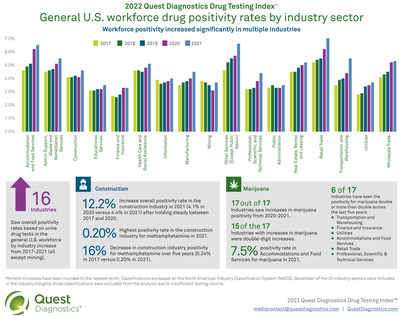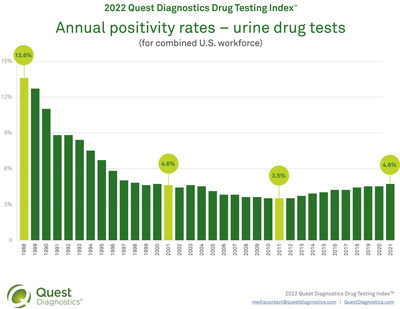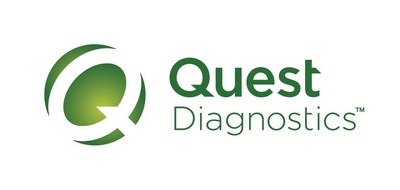Workforce Drug Test Positivity Climbs to Highest Level in Two Decades, Finds Quest Diagnostics Drug Testing Index Analysis
Quest Diagnostics reported a significant rise in drug test positivity rates in the U.S. workforce, reaching the highest levels since 2001. The overall positivity rate for urine tests increased to 4.6% in 2021, up 31.4% from an all-time low in 2010-2012. Notably, federally mandated safety-sensitive workers' positivity remained steady at 2.2%. Marijuana positivity in the general workforce rose to 3.9%, marking a 50% increase over five years. Employers face challenges in recruitment while ensuring workplace safety amidst these trends.
- Overall drug positivity rate in the U.S. workforce increased to 4.6% in 2021.
- Marijuana positivity in the general workforce rose to 3.9%, a 50% increase over five years.
- Positivity rates for safety-sensitive roles remained steady at 2.2%.
- Post-accident drug test positivity rates increased significantly, raising safety concerns.
- Employers may be compelled to relax drug testing policies to attract talent.
Insights
Analyzing...
Positivity for Cocaine and Marijuana Increase for Federally Mandated, Safety-Sensitive Workers Required to Test Under Federal Law
Amid Widespread Recruiting and Retention Challenges, Drug Positivity Increases in Post-Accident Tests at a Faster Rate Than Pre-Employment Tests for Cocaine, Marijuana, Opiates and Oxycodones
SECAUCUS, N.J., March 30, 2022 /PRNewswire/ -- The rate of positive drug test results among America's workforce reached its highest rate last year since 2001 and was up more than
The study, based on more than 11 million deidentified urine, hair and oral fluid drug test results collected between January and December 2021, offers revealing insights into workforce drug use as employers grapple with creating safe, healthful work environments amid an ongoing recruitment and retention crisis.
The overall positivity rate in the combined U.S. workforce, based on nearly nine million urine drug tests collected between January and December 2021, was up in 2021 to
Overall positivity in the federally mandated, safety-sensitive workforce based on nearly 2.7 million urine drug tests stayed even year over year (
For an interactive map of the Drug Testing Index with positivity rates and trend lines by drug categories and three-digit ZIP code in the United States, visit DTIDrugMap.com.
"Our Drug Testing Index reveals several notable trends, such as increased drug positivity rates in the safety-sensitive workforce, including those performing public safety and national security jobs, as well as higher rates of positivity in individuals tested after on-the-job accidents," said Barry Sample, PhD, Senior Science Consultant for Quest Diagnostics.
"Employers are wrestling with significant recruitment and retention challenges as well as with maintaining safe and engaging work environments that foster positive mental and physical wellbeing," said Keith Ward, General Manager and Vice President, Quest Diagnostics Employer Solutions. "Our Drug Testing Index data raises important questions about what it means to be an employer committed to employee health and safety. Eager to attract talent, employers may be tempted to lower their standards. In the process, they raise the specter of more drug-related impairment and worksite accidents that put other employees and the general public in harms' way."
The new findings of the Quest Diagnostics Drug Testing Index™ are being unveiled this week at the Drug & Alcohol Testing Association 2022 Conference taking place March 30-April 2 in Louisville, KY.
Despite years of decline, positivity rates increased in several federally mandated, safety-sensitive workforce testing categories
After five years of steady declines in several drug categories, positivity rates based on urine drug tests for the federally mandated, safety-sensitive workforce increased in 2021. Of note, marijuana increased
"It is important for workers to know that certain employers are required to test for marijuana under federal law and if they use marijuana, they can still lose their jobs," said Dr. Sample. "People who use drugs during working hours or before work can still be impaired and dangerous to co-workers, the general public and themselves."
Positivity for marijuana continues upward climb in general U.S. workforce
Positivity rates for marijuana in the general U.S. workforce, based on more than 6 million urine tests, continued an upward climb, increasing
In oral fluid testing, overall workforce drug positivity decreased, but increased for marijuana, methamphetamine and cocaine
In 2021, positivity in the general U.S. workforce based on oral fluid was
Oral fluid tests generally have a shorter window of drug detection than urine, and can detect some drugs faster, in a matter of minutes versus hours. Oral fluid collection also has the advantage of being observed, making it harder to subvert the testing process.
Urine positivity rates for post-accident testing increased at a greater rate than pre-employment testing over five years, driven by higher positivity on post-accident tests for marijuana, cocaine, and semi-synthetic opiates
Over the last five years in general U.S. workforce urine drug testing, pre-employment positivity increased
Similarly, in federally mandated, safety-sensitive workforce urine drug testing, pre-employment positivity increased
"Drug use affecting the work environment is a complex problem that is not going away," said Jenny Burke, Vice President of Impairment Practice, National Safety Council. "When workers use impairing substances, it can create incidents that compromise the safety of other workers and, in some cases, the general public. Employers should have the right and ability to maintain a substance-free workplace and the use of drug testing, including oral fluid in addition to urine. NSC supports policies and procedures that ensure safe and healthy workplaces."
In 2021, urine post-accident testing in the U.S. general workforce for the drugs marijuana and cocaine the positivity rate was
For federally mandated, safety-sensitive workforce urine drug testing in 2021, post-accident positivity for marijuana, cocaine, opiates (hydrocodone/hydromorphone) and oxycodones (oxycodone/oxymorphone) was
Pre-employment drug tests are meant to be a deterrent in hiring workers whose drug-use behavior may cause unsafe work conditions or poor work performance. Post-accident testing is conducted to evaluate whether drug use may have played a role in the workplace incident prompting the drug test.
"The increase in post-accident positivity is alarming and suggests more drug-associated accidents may be occurring even with employers with pre-employment drug testing in place," Dr. Sample said. "The high cost of work accidents cannot be understated. While employers often think of accidents in terms of wage and productivity losses, medical expenses, and administrative expenses, accidents also impact morale, competitiveness and recruiting. Given that employers are in a war for talent, creating a safe, healthful work environment is critical for attracting and retaining people."
Mixed picture for cocaine positivity in the general U.S. workforce
Positivity for cocaine based on urine tests in the general U.S. workforce decreased
Positivity for opiates and oxycodones in the general U.S. workforce decreased last year and over five years
Positivity for opiates (codeine/morphine) based on urine drug tests in the general U.S. workforce decreased
Positivity for 6-AM (heroin) in the general U.S. workforce decreased over five years
Positivity for 6-AM metabolite (heroin) based on urine tests in the general U.S. workforce decreased
Retail Trade had highest positivity among key industries
The overall positivity rate increased in 16 out of 17 industries from 2017 to 2021. Retail Trade industry had the highest overall positivity rate in 2021, at
Marijuana positivity increased in all industries and by double-digits in 15 from 2017 to 2021. The Accommodation and Food Service industry had the highest workforce positivity for marijuana at
In the Health Care and Social Assistance industry, results saw positivity for methamphetamine decrease year-over-year. Across the last five years, it decreased by
About the Quest Diagnostics Drug Testing Index™
The Quest Diagnostics Drug Testing Index™ (DTI) is a series of reports that provide insights into trends in workforce drug use based on positivity rates of deidentified laboratory tests performed by Quest Diagnostics for a range of illicit, legal and prescription drugs. It examines test results according to three categories of workers: federally mandated, safety-sensitive workers; the general U.S. workforce; and the combined U.S. workforce. Federally mandated, safety-sensitive workers include pilots, bus and truck drivers, and workers in nuclear power plants, for whom routine drug testing is mandated by government agencies like the Department of Transportation, Nuclear Regulatory Commission and the Department of Defense.
The strengths of the DTI analysis include its large, nationally representative sample size, longitudinal monitoring, a testing population that is generally reflective of the U.S. workforce and the quality of the company's drug testing services to confirm positive results. Limitations include analysis only of employers that perform drug testing with the company, and a lack of exact cross-specimen comparisons due to variations in substances for which employers test. Quest Diagnostics has analyzed annual workplace drug testing data since 1988 and publishes the findings as a public service.
Quest Diagnostics is the leading workforce drug testing provider, offering a broad range of drug testing options that allow employers to combine and customize a drug testing program that meets their unique business needs, all from a single, convenient provider. Employers seeking information on the company's services should visit the company's Employer Solutions page for more information.
About Quest Diagnostics
Quest Diagnostics empowers people to take action to improve health outcomes. Derived from the world's largest database of clinical lab results, our diagnostic insights reveal new avenues to identify and treat disease, inspire healthy behaviors, and improve health care management. Quest annually serves one in three adult Americans and half the physicians and hospitals in the United States, and our nearly 50,000 employees understand that, in the right hands and with the right context, our diagnostic insights can inspire actions that transform lives. www.QuestDiagnostics.com.
![]() View original content to download multimedia:https://www.prnewswire.com/news-releases/workforce-drug-test-positivity-climbs-to-highest-level-in-two-decades-finds-quest-diagnostics-drug-testing-index-analysis-301513730.html
View original content to download multimedia:https://www.prnewswire.com/news-releases/workforce-drug-test-positivity-climbs-to-highest-level-in-two-decades-finds-quest-diagnostics-drug-testing-index-analysis-301513730.html
SOURCE Quest Diagnostics











